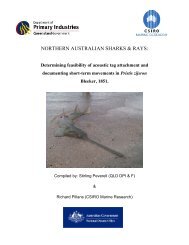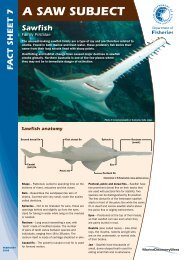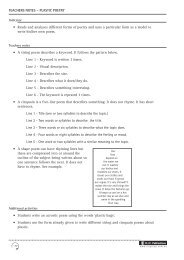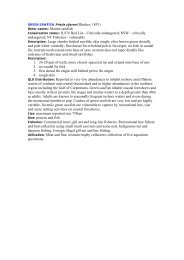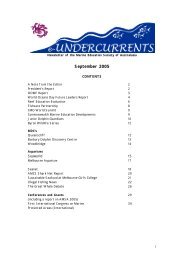The cultural significance of sharks and rays in Aboriginal societies ...
The cultural significance of sharks and rays in Aboriginal societies ...
The cultural significance of sharks and rays in Aboriginal societies ...
Create successful ePaper yourself
Turn your PDF publications into a flip-book with our unique Google optimized e-Paper software.
high prote<strong>in</strong> <strong>and</strong> vitam<strong>in</strong>-packed delicacy) is reta<strong>in</strong>ed. <strong>The</strong> ray<br />
is then roasted <strong>in</strong> hot coals or boiled for half an hour. Once<br />
fully cooked, the meat is shredded, soaked <strong>in</strong> freshwater, then<br />
r<strong>in</strong>sed with seawater. Next, h<strong>and</strong>fuls <strong>of</strong> meat are squeezed to<br />
remove the water <strong>and</strong> juices. This step removes the pungent<br />
ammonia that can permeate shark flesh, mak<strong>in</strong>g it taste bad.<br />
F<strong>in</strong>ally, the heated or raw liver is kneaded <strong>in</strong>to the shredded<br />
meat. <strong>The</strong> f<strong>in</strong>ished mixture, which tastes like succulent buttered<br />
crabmeat, is then separated <strong>in</strong>to small round cakes <strong>and</strong> shared<br />
with relatives. This recipe is remarkably consistent throughout<br />
<strong>societies</strong> along the northern coastl<strong>in</strong>es.<br />
Utilisation <strong>of</strong> <strong>sharks</strong> <strong>and</strong> <strong>rays</strong> for food is so central to<br />
<strong>in</strong>digenous thought that it <strong>in</strong>fluences how Aborig<strong>in</strong>al <strong>societies</strong><br />
classify these animals. In Western science, elasmobranchs<br />
are separated from the bony fishes because they possess a<br />
cartilag<strong>in</strong>ous skeleton. In contrast, Aborig<strong>in</strong>al groups separate<br />
the <strong>sharks</strong> <strong>and</strong> <strong>rays</strong> from bony fishes based on this unusual<br />
cook<strong>in</strong>g technique. Among the Lardil<br />
people <strong>of</strong> Morn<strong>in</strong>gton<br />
Isl<strong>and</strong>, for <strong>in</strong>stance, the sign language term for ‘elasmobranch’<br />
(used when silence is desired, as when hunt<strong>in</strong>g), is a fist rest<strong>in</strong>g<br />
<strong>in</strong> a cupped h<strong>and</strong>–an approximation <strong>of</strong> the round st<strong>in</strong>gray cake!<br />
Traditionally, <strong>in</strong>digenous peoples did not share the Western<br />
notion <strong>of</strong> environmental conservation. <strong>The</strong>y believed that food<br />
animals were released <strong>in</strong>to the l<strong>and</strong>scape by the ancestors<br />
as needed, so long as proper relations were ma<strong>in</strong>ta<strong>in</strong>ed with<br />
them through ceremony, art, <strong>and</strong> song. However, exploitation<br />
<strong>of</strong> animal species was controlled based on laws established<br />
by the ancestors dur<strong>in</strong>g the creation period. As a result, most<br />
food species were only harvested seasonally, like when the<br />
calendar plants were <strong>in</strong> bloom. If hunters harvested animals out<br />
<strong>of</strong> season, they could be punished by the clan responsible for<br />
ma<strong>in</strong>ta<strong>in</strong><strong>in</strong>g ritual relations with that species. <strong>The</strong>se ancestral<br />
laws served to assure a steady supply <strong>of</strong> <strong>sharks</strong> <strong>and</strong> <strong>rays</strong> every<br />
year without trigger<strong>in</strong>g the massive population collapses which<br />
plague Western ‘maximum susta<strong>in</strong>able yield’ fisheries.<br />
Sharks <strong>and</strong> <strong>rays</strong> were also traditionally used to manufacture a<br />
variety <strong>of</strong> tools, weapons, <strong>and</strong> implements. On Groote Eyl<strong>and</strong>t,<br />
for <strong>in</strong>stance, the toothy snout <strong>of</strong> small sawfishes was sometimes<br />
used as a hair comb. Elasmobranch vertebrae, <strong>in</strong>trigu<strong>in</strong>g round<br />
spool-shaped disks, were strung as beads to make ornamental<br />
necklaces. Shark teeth were utilized to make carv<strong>in</strong>g<br />
implements <strong>and</strong> rough shark hide was sometimes used like<br />
s<strong>and</strong>paper. Shark teeth were also set <strong>in</strong>to wooden clubs to make<br />
flesh-ripp<strong>in</strong>g swords. Large sawfish snouts were also fashioned<br />
<strong>in</strong>to <strong>in</strong>timidat<strong>in</strong>g war clubs. Similarly, spears were sometimes<br />
tipped with a bristl<strong>in</strong>g bouquet <strong>of</strong> venomous st<strong>in</strong>gray sp<strong>in</strong>es.<br />
Wounds caused by this fearsome weapon were nearly always<br />
fatal. <strong>The</strong> Wik<br />
peoples <strong>of</strong> Cape York would sometimes cut r<strong>in</strong>gs<br />
from the tails <strong>of</strong> thorny <strong>rays</strong>, creat<strong>in</strong>g sp<strong>in</strong>y ‘brass knuckles’<br />
which made punches more dangerous dur<strong>in</strong>g fight<strong>in</strong>g.<br />
Totemism demystified<br />
While Aborig<strong>in</strong>al religion rema<strong>in</strong>s largely unfamiliar to the<br />
average Australian, an <strong>in</strong>troduction to the basic concepts will<br />
allow a deeper appreciation for the role shark <strong>and</strong> ray totemic<br />
ancestors play <strong>in</strong> Top End cultures. Aborig<strong>in</strong>al <strong>societies</strong> are<br />
divided <strong>in</strong>to extended family groups called clans. Totemism<br />
is a belief that each family clan traces its ancestry to a dist<strong>in</strong>ct<br />
group <strong>of</strong> ancestral creator be<strong>in</strong>gs (sometimes called totems),<br />
dist<strong>in</strong>ct from the div<strong>in</strong>e ancestry <strong>of</strong> every other clan.<br />
Dur<strong>in</strong>g the primal creation period, many ancestral be<strong>in</strong>gs<br />
emerged from the unformed earth, sea, <strong>and</strong> sky. <strong>The</strong>se<br />
superhuman creators had the power to transform <strong>in</strong>to any<br />
form they desired, <strong>in</strong>clud<strong>in</strong>g animals, plants, natural forces,<br />
or people. <strong>The</strong>y were restless, so they journeyed across the<br />
formless world search<strong>in</strong>g for a place to rest for eternity.<br />
<strong>The</strong>y lived much as people live today, but their actions had<br />
cosmological consequences, shap<strong>in</strong>g the l<strong>and</strong>scape <strong>and</strong><br />
creat<strong>in</strong>g features such as rivers, valleys, bays, rock formations,<br />
<strong>and</strong> trees. Eventually, each ancestor found a location to their<br />
lik<strong>in</strong>g, transform<strong>in</strong>g <strong>in</strong>to a l<strong>and</strong> feature or dissolv<strong>in</strong>g <strong>in</strong>to the<br />
l<strong>and</strong>scape. Before the ancestors disappeared, they bestowed<br />
their l<strong>and</strong> estate upon human descendants <strong>and</strong> taught them the<br />
sacred designs, power-names, songs, <strong>and</strong> dances necessary to<br />
rema<strong>in</strong> <strong>in</strong> contact with the ancestor.<br />
By follow<strong>in</strong>g the sacred laws established by the ancestors<br />
<strong>and</strong> re-enact<strong>in</strong>g their journey through pa<strong>in</strong>t<strong>in</strong>g, song, <strong>and</strong><br />
dance, humans cont<strong>in</strong>ue to ma<strong>in</strong>ta<strong>in</strong> their l<strong>in</strong>k to the life-force<br />
which ensures both human well be<strong>in</strong>g <strong>and</strong> the fecundity <strong>of</strong> the<br />
l<strong>and</strong>scape. <strong>The</strong>se songs <strong>and</strong> designs serve both as statements<br />
<strong>of</strong> clan identity <strong>and</strong> function as legal l<strong>and</strong> title under native<br />
law. Nowadays, the presence <strong>of</strong> the ancestors is revealed both<br />
through the l<strong>and</strong>forms they created <strong>and</strong> as the life-force which<br />
animates the plants, animals, <strong>and</strong> natural forces on the clan<br />
l<strong>and</strong> estate.<br />
Below are three representative stories from Aborig<strong>in</strong>al groups<br />
reveal<strong>in</strong>g the importance <strong>of</strong> <strong>sharks</strong> <strong>and</strong> <strong>rays</strong> as ancestral<br />
creators. First, we will learn about two ancestors <strong>of</strong> the<br />
Yolngu peoples <strong>of</strong> northeast Arnhem L<strong>and</strong>: the powerful shark<br />
creator Mäna who embodies justified vengeance, <strong>and</strong> then<br />
Gawangalkmirri, a totemic st<strong>in</strong>gray which symbolises <strong>cultural</strong><br />
survival. F<strong>in</strong>ally, we will follow a school <strong>of</strong> creator <strong>rays</strong> <strong>and</strong><br />
sawfishes to Groote Eyl<strong>and</strong>t, where their presence cont<strong>in</strong>ues to<br />
permeate the l<strong>and</strong>s that they created.<br />
<strong>The</strong> shark: Mäna<br />
For the Yolngu peoples <strong>of</strong> northeast Arnhem L<strong>and</strong>, certa<strong>in</strong><br />
ancestors who created potent sacred sites are known as ‘power<br />
totems’. <strong>The</strong>se ancestors are central to the identity <strong>of</strong> the<br />
clans descended from them, <strong>and</strong> clansmen draw spiritual <strong>and</strong><br />
3





